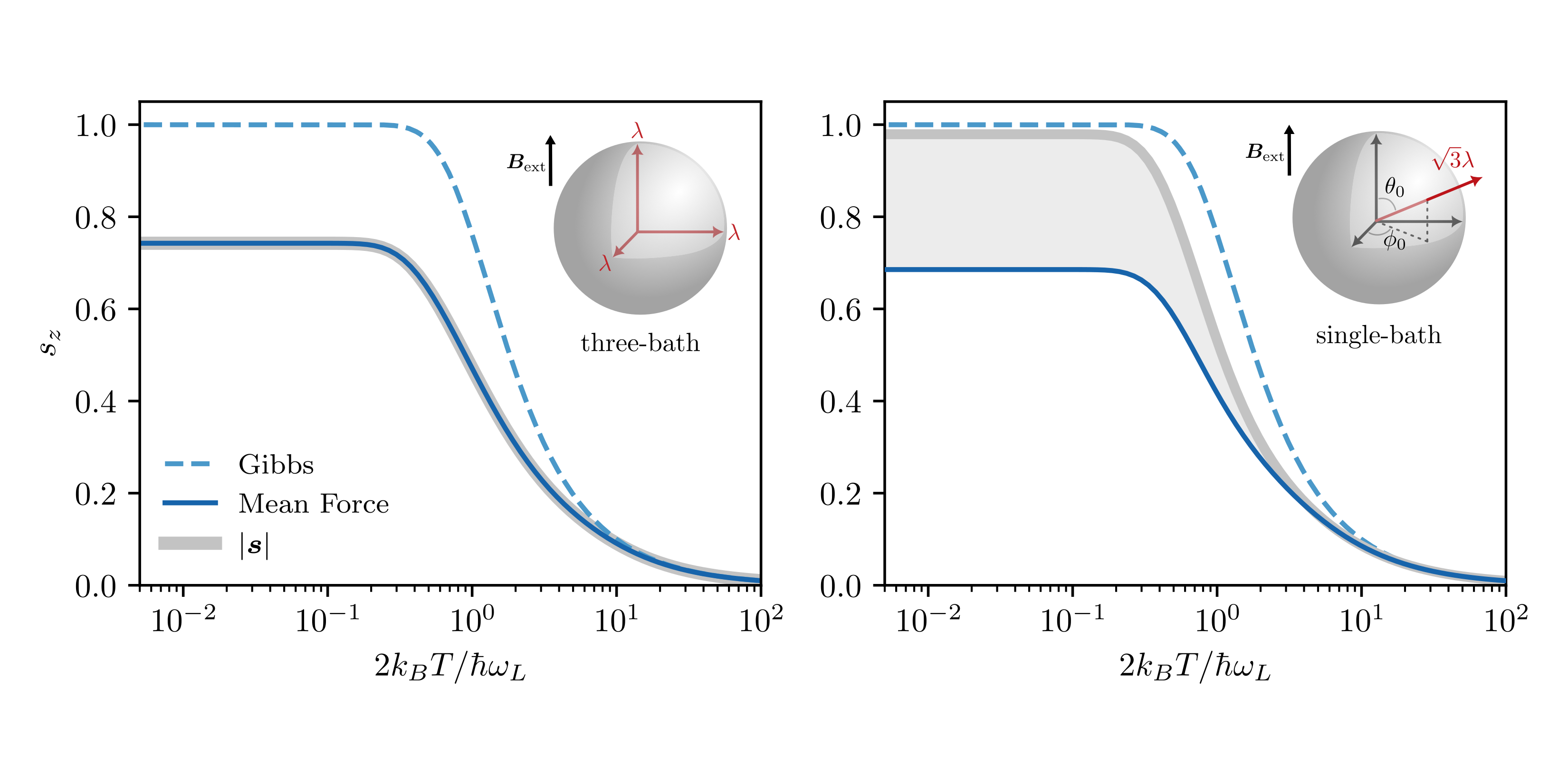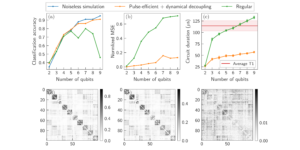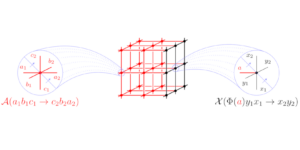1Department of Physics and Astronomy, University of Exeter, Stocker Road, Exeter EX4 4QL, United Kingdom.
2Department of Engineering Science, University of Oxford, Parks Road, Oxford OX1 3PJ, United Kingdom.
3School of Physics and Astronomy, University of Glasgow, Glasgow, G12 8QQ, United Kingdom.
4Department of Physics and Astronomy, Macquarie University, 2109 NSW, Australia.
5Institut für Physik und Astronomie, University of Potsdam, 14476 Potsdam, Germany.
Find this paper interesting or want to discuss? Scite or leave a comment on SciRate.
Abstract
The spin-boson model usually considers a spin coupled to a single bosonic bath. However, some physical situations require coupling of the spin to multiple environments. For example, spins interacting with phonons in three-dimensional magnetic materials. Here, we consider a spin coupled isotropically to three independent baths. We show that coupling to multiple baths can significantly increase entanglement between the spin and its environment at zero temperature. The effect of this is to reduce the spin’s expectation values in the mean force equilibrium state. In contrast, the classical three-bath spin equilibrium state turns out to be entirely independent of the environmental coupling. These results reveal purely quantum effects that can arise from multi-bath couplings, with potential applications in a wide range of settings, such as magnetic materials.

Featured image: Impact of multi-bath coupling on spin-boson equilibrium states. The three-bath model (left) exhibits significantly more spin-bath entanglement than a comparable single-bath model (right) at zero temperature, indicated by a lower value of the effective spin length $|mathbf{s}|$ (grey line).
Popular summary
In this paper, we establish the impact of coupling each of the three spin components to an independent environment and compare to the standard single-environment spin boson model. We show that coupling to multiple environments can significantly increase the entanglement between spin and environment at zero temperature. Practically, this entanglement leads to a reduction in the effective spin length. Furthermore, whilst the state of the quantum spin varies with environmental coupling strength, we find that the isotropic classical analogue is invariant. These results reveal purely quantum effects that can arise from multi-bath couplings.
► BibTeX data
► References
[1] M. A. Nielsen and I. L. Chuang. “Quantum computation and quantum information: 10th anniversary edition”. Cambridge University Press. (2010).
[2] R. Horodecki, P. Horodecki, M. Horodecki, and K. Horodecki. “Quantum entanglement”. Reviews of Modern Physics 81, 865–942 (2009).
https://doi.org/10.1103/revmodphys.81.865
[3] J. Goold, M. Huber, A. Riera, L. del Rio, and P. Skrzypczyk. “The role of quantum information in thermodynamics—a topical review”. Journal of Physics A: Mathematical and Theoretical 49, 143001 (2016).
https://doi.org/10.1088/1751-8113/49/14/143001
[4] X. L. Huang, H. Xu, X. Y. Niu, and Y. D. Fu. “A special entangled quantum heat engine based on the two-qubit Heisenberg XX model”. Physica Scripta 88, 065008 (2013).
https://doi.org/10.1088/0031-8949/88/06/065008
[5] A. Hewgill, A. Ferraro, and G. De Chiara. “Quantum correlations and thermodynamic performances of two-qubit engines with local and common baths”. Physical Review A 98, 042102 (2018).
https://doi.org/10.1103/physreva.98.042102
[6] L. Bresque, P. A. Camati, S. Rogers, K. Murch, A. N. Jordan, and A. Auffèves. “Two-qubit engine fueled by entanglement and local measurements”. Physical Review Letters 126, 120605 (2021).
https://doi.org/10.1103/physrevlett.126.120605
[7] N. Boudjada and D. Segal. “From dissipative dynamics to studies of heat transfer at the nanoscale: analysis of the spin-boson model”. The Journal of Physical Chemistry A 118, 11323–11336 (2014).
https://doi.org/10.1021/jp5091685
[8] A. O. Caldeira and A. J. Leggett. “Path integral approach to quantum Brownian motion”. Physica A: Statistical Mechanics and its Applications 121, 587–616 (1983).
https://doi.org/10.1016/0378-4371(83)90013-4
[9] H.-P. Breuer and F. Petruccione. “The theory of open quantum systems”. Oxford University Press. (2002).
[10] A. Lemmer, C. Cormick, D. Tamascelli, T. Schaetz, S. F. Huelga, and M. B. Plenio. “A trapped-ion simulator for spin-boson models with structured environments”. New Journal of Physics 20, 073002 (2018).
https://doi.org/10.1088/1367-2630/aac87d
[11] N. Lambert, S. Ahmed, M. Cirio, and F. Nori. “Modelling the ultra-strongly coupled spin-boson model with unphysical modes”. Nature Communications 10, 3721 (2019).
https://doi.org/10.1038/s41467-019-11656-1
[12] G. Guarnieri, M. Kolář, and R. Filip. “Steady-state coherences by composite system-bath interactions”. Physical Review Letters 121, 070401 (2018).
https://doi.org/10.1103/physrevlett.121.070401
[13] A. Purkayastha, G. Guarnieri, M. T. Mitchison, R. Filip, and J. Goold. “Tunable phonon-induced steady-state coherence in a double-quantum-dot charge qubit”. npj Quantum Information 6, 27 (2020).
https://doi.org/10.1038/s41534-020-0256-6
[14] T. A. Costi and R. H. McKenzie. “Entanglement between a qubit and the environment in the spin-boson model”. Physical Review A 68, 034301 (2003).
https://doi.org/10.1103/physreva.68.034301
[15] N. Lambert, C. Emary, and T. Brandes. “Entanglement and entropy in a spin-boson quantum phase transition”. Physical Review A 71, 053804 (2005).
https://doi.org/10.1103/physreva.71.053804
[16] A. Kopp and K. Le Hur. “Universal and measurable entanglement entropy in the spin-boson model”. Physical Review Letters 98, 220401 (2007).
https://doi.org/10.1103/physrevlett.98.220401
[17] L. Amico, R. Fazio, A. Osterloh, and V. Vedral. “Entanglement in many-body systems”. Reviews of Modern Physics 80, 517–576 (2008).
https://doi.org/10.1103/revmodphys.80.517
[18] S. Bera, A. Nazir, A. W. Chin, H. U. Baranger, and S. Florens. “Generalized multipolaron expansion for the spin-boson model: environmental entanglement and the biased two-state system”. Physical Review B 90, 075110 (2014).
https://doi.org/10.1103/physrevb.90.075110
[19] V. A. Wasesatama and J. S. Kosasih. “Entanglement dynamics of non-linearly coupled spin-boson model using hierarchical equation of motion approach”. Journal of Physics: Conference Series 2243, 012116 (2022).
https://doi.org/10.1088/1742-6596/2243/1/012116
[20] J. Anders, C. R. J. Sait, and S. A. R. Horsley. “Quantum Brownian motion for magnets”. New Journal of Physics 24, 033020 (2022).
https://doi.org/10.1088/1367-2630/ac4ef2
[21] J. O. Thomas, B. Limburg, J. K. Sowa, K. Willick, J. Baugh, G. A. D. Briggs, E. M. Gauger, H. L. Anderson, and J. A. Mol. “Understanding resonant charge transport through weakly coupled single-molecule junctions”. Nature Communications 10, 4628 (2019).
https://doi.org/10.1038/s41467-019-12625-4
[22] G. G. Giusteri, F. Recrosi, G. Schaller, and G. L. Celardo. “Interplay of different environments in open quantum systems: breakdown of the additive approximation”. Physical Review E 96, 012113 (2017).
https://doi.org/10.1103/physreve.96.012113
[23] M. T. Mitchison and M. B. Plenio. “Non-additive dissipation in open quantum networks out of equilibrium”. New Journal of Physics 20, 033005 (2018).
https://doi.org/10.1088/1367-2630/aa9f70
[24] J. Kołodyński, J. B. Brask, M. Perarnau-Llobet, and B. Bylicka. “Adding dynamical generators in quantum master equations”. Physical Review A 97, 062124 (2018).
https://doi.org/10.1103/physreva.97.062124
[25] C. McConnell and A. Nazir. “Electron counting statistics for non-additive environments”. The Journal of Chemical Physics 151, 054104 (2019).
https://doi.org/10.1063/1.5095838
[26] D. Gribben, D. M. Rouse, J. Iles-Smith, A. Strathearn, H. Maguire, P. Kirton, A. Nazir, E. M. Gauger, and B. W. Lovett. “Exact dynamics of nonadditive environments in non-Markovian open quantum systems”. PRX Quantum 3, 010321 (2022).
https://doi.org/10.1103/prxquantum.3.010321
[27] A. H. Castro Neto, E. Novais, L. Borda, G. Zaránd, and I. Affleck. “Quantum magnetic impurities in magnetically ordered systems”. Physical Review Letters 91, 096401 (2003).
https://doi.org/10.1103/physrevlett.91.096401
[28] E. Novais, A. H. Castro Neto, L. Borda, I. Affleck, and G. Zarand. “Frustration of decoherence in open quantum systems”. Physical Review B 72, 014417 (2005).
https://doi.org/10.1103/physrevb.72.014417
[29] C. Guo, A. Weichselbaum, J. von Delft, and M. Vojta. “Critical and strong-coupling phases in one- and two-bath spin-boson models”. Physical Review Letters 108, 160401 (2012).
https://doi.org/10.1103/physrevlett.108.160401
[30] J. Otsuki. “Spin-boson coupling in continuous-time quantum monte carlo”. Physical Review B 87, 125102 (2013).
https://doi.org/10.1103/physrevb.87.125102
[31] H. Kohler, A. Hackl, and S. Kehrein. “Nonequilibrium dynamics of a system with quantum frustration”. Physical Review B 88, 205122 (2013).
https://doi.org/10.1103/physrevb.88.205122
[32] B. Bruognolo, A. Weichselbaum, C. Guo, J. von Delft, I. Schneider, and M. Vojta. “Two-bath spin-boson model: phase diagram and critical properties”. Physical Review B 90, 245130 (2014).
https://doi.org/10.1103/physrevb.90.245130
[33] A. Cai and Q. Si. “Bose-Fermi Anderson model with SU(2) symmetry: continuous-time quantum Monte Carlo study”. Physical Review B 100, 014439 (2019).
https://doi.org/10.1103/physrevb.100.014439
[34] M. Weber and M. Vojta. “SU(2)-symmetric spin-boson model: quantum criticality, fixed-point annihilation, and duality”. Physical Review Letters 130, 186701 (2023).
https://doi.org/10.1103/physrevlett.130.186701
[35] N. Anto-Sztrikacs and D. Segal. “Strong coupling effects in quantum thermal transport with the reaction coordinate method”. New Journal of Physics 23, 063036 (2021).
https://doi.org/10.1088/1367-2630/ac02df
[36] A. Kato and Y. Tanimura. “Quantum heat current under non-perturbative and non-Markovian conditions: applications to heat machines”. The Journal of Chemical Physics 145, 224105 (2016).
https://doi.org/10.1063/1.4971370
[37] C. Duan, C.-Y. Hsieh, J. Liu, J. Wu, and J. Cao. “Unusual transport properties with noncommutative system–bath coupling operators”. The Journal of Physical Chemistry Letters 11, 4080–4085 (2020).
https://doi.org/10.1021/acs.jpclett.0c00985
[38] N. Anto-Sztrikacs, F. Ivander, and D. Segal. “Quantum thermal transport beyond second order with the reaction coordinate mapping”. The Journal of Chemical Physics 156, 214107 (2022).
https://doi.org/10.1063/5.0091133
[39] S. Nemati, C. Henkel, and J. Anders. “Coupling function from bath density of states”. Europhysics Letters 139, 36002 (2022).
https://doi.org/10.1209/0295-5075/ac7b42
[40] R. F. L. Evans, W. J. Fan, P. Chureemart, T. A. Ostler, M. O. A. Ellis, and R. W. Chantrell. “Atomistic spin model simulations of magnetic nanomaterials”. Journal of Physics: Condensed Matter 26, 103202 (2014).
https://doi.org/10.1088/0953-8984/26/10/103202
[41] J. Barker and G. E. W. Bauer. “Semiquantum thermodynamics of complex ferrimagnets”. Physical Review B 100, 140401(R) (2019).
https://doi.org/10.1103/physrevb.100.140401
[42] N. A. Usov and O. N. Serebryakova. “Equilibrium properties of assembly of interacting superparamagnetic nanoparticles”. Scientific Reports 10, 13677 (2020).
https://doi.org/10.1038/s41598-020-70711-w
[43] B. Huttner and S. M. Barnett. “Quantization of the electromagnetic field in dielectrics”. Physical Review A 46, 4306–4322 (1992).
https://doi.org/10.1103/physreva.46.4306
[44] F. Hartmann, S. Scali, and J. Anders. “Anisotropic signatures in the spin-boson model”. Physical Review B 108, 184402 (2023).
https://doi.org/10.1103/physrevb.108.184402
[45] F. Cerisola, M. Berritta, S. Scali, S. A. R. Horsley, J. D. Cresser, and J. Anders. “Quantum-classical correspondence in spin-boson equilibrium states at arbitrary coupling”. New Journal of Physics (2024).
https://doi.org/10.1088/1367-2630/ad4818
[46] K. Neeraj, N. Awari, S. Kovalev, D. Polley, N. Zhou Hagström, S. S. P. K. Arekapudi, A. Semisalova, K. Lenz, B. Green, J.-C. Deinert, I. Ilyakov, M. Chen, M. Bawatna, V. Scalera, M. d’Aquino, C. Serpico, O. Hellwig, J.-E. Wegrowe, M. Gensch, and S. Bonetti. “Inertial spin dynamics in ferromagnets”. Nature Physics 17, 245–250 (2021).
https://doi.org/10.1038/s41567-020-01040-y
[47] A. S. Trushechkin, M. Merkli, J. D. Cresser, and J. Anders. “Open quantum system dynamics and the mean force Gibbs state”. AVS Quantum Science 4, 012301 (2022).
https://doi.org/10.1116/5.0073853
[48] H. J. D. Miller. “Hamiltonian of mean force for strongly-coupled systems”. In F. Binder, L. A. Correa, C. Gogolin, J. Anders, and G. Adesso, editors, Thermodynamics in the quantum regime. Page 531–549. Springer International Publishing, Cham (2018).
https://doi.org/10.1007/978-3-319-99046-0_22
[49] J. Thingna, J.-S. Wang, and P. Hänggi. “Generalized Gibbs state with modified Redfield solution: exact agreement up to second order”. The Journal of Chemical Physics 136, 194110 (2012).
https://doi.org/10.1063/1.4718706
[50] Y. Subaşı, C. H. Fleming, J. M. Taylor, and B. L. Hu. “Equilibrium states of open quantum systems in the strong coupling regime”. Physical Review E 86, 061132 (2012).
https://doi.org/10.1103/physreve.86.061132
[51] J. D. Cresser and J. Anders. “Weak and ultrastrong coupling limits of the quantum mean force Gibbs state”. Physical Review Letters 127, 250601 (2021).
https://doi.org/10.1103/physrevlett.127.250601
[52] M. Merkli. “Dynamics of open quantum systems I, oscillation and decay”. Quantum 6, 615 (2022).
https://doi.org/10.22331/q-2022-01-03-615
[53] M. Merkli. “Dynamics of open quantum systems II, Markovian approximation”. Quantum 6, 616 (2022).
https://doi.org/10.22331/q-2022-01-03-616
[54] J. G. Kirkwood. “Statistical mechanics of fluid mixtures”. The Journal of Chemical Physics 3, 300–313 (1935).
https://doi.org/10.1063/1.1749657
[55] C. Lu, C. Wu, D. Ghoreishi, W. Chen, L. Wang, W. Damm, G. A. Ross, M. K. Dahlgren, E. Russell, C. D. Von Bargen, R. Abel, R. A. Friesner, and E. D. Harder. “OPLS4: improving force field accuracy on challenging regimes of chemical space”. Journal of Chemical Theory and Computation 17, 4291–4300 (2021).
https://doi.org/10.1021/acs.jctc.1c00302
[56] A. Garg, J. N. Onuchic, and V. Ambegaokar. “Effect of friction on electron transfer in biomolecules”. The Journal of Chemical Physics 83, 4491–4503 (1985).
https://doi.org/10.1063/1.449017
[57] J. Iles-Smith, N. Lambert, and A. Nazir. “Environmental dynamics, correlations, and the emergence of noncanonical equilibrium states in open quantum systems”. Physical Review A 90, 032114 (2014).
https://doi.org/10.1103/physreva.90.032114
[58] J. Iles-Smith, A. G. Dijkstra, N. Lambert, and A. Nazir. “Energy transfer in structured and unstructured environments: master equations beyond the Born-Markov approximations”. The Journal of Chemical Physics 144, 044110 (2016).
https://doi.org/10.1063/1.4940218
[59] P. Strasberg, G. Schaller, N. Lambert, and T. Brandes. “Nonequilibrium thermodynamics in the strong coupling and non-Markovian regime based on a reaction coordinate mapping”. New Journal of Physics 18, 073007 (2016).
https://doi.org/10.1088/1367-2630/18/7/073007
[60] A. Nazir and G. Schaller. “The reaction coordinate mapping in quantum thermodynamics”. In F. Binder, L. A. Correa, C. Gogolin, J. Anders, and G. Adesso, editors, Thermodynamics in the quantum regime. Pages 551–577. Springer International Publishing, Cham (2018).
https://doi.org/10.1007/978-3-319-99046-0_23
[61] L. A. Correa, B. Xu, B. Morris, and G. Adesso. “Pushing the limits of the reaction-coordinate mapping”. The Journal of Chemical Physics 151, 094107 (2019).
https://doi.org/10.1063/1.5114690
[62] N. Anto-Sztrikacs and D. Segal. “Capturing non-Markovian dynamics with the reaction coordinate method”. Physical Review A 104, 052617 (2021).
https://doi.org/10.1103/physreva.104.052617
[63] The TEMPO collaboration. “OQuPy: a Python 3 package to efficiently compute non-Markovian open quantum systems” (2020).
[64] A. Strathearn, P. Kirton, D. Kilda, J. Keeling, and B. W. Lovett. “Efficient non-Markovian quantum dynamics using time-evolving matrix product operators”. Nature Communications 9, 3322 (2018).
https://doi.org/10.1038/s41467-018-05617-3
[65] M. B. Plenio and S. Virmani. “An introduction to entanglement measures”. Quantum Information and Computation 7, 1–51 (2007).
https://doi.org/10.26421/qic7.1-2-1
[66] J. Anders. “Thermal state entanglement in harmonic lattices”. Physical Review A 77, 062102 (2008).
https://doi.org/10.1103/physreva.77.062102
[67] G. Sadiek and S. Almalki. “Thermal robustness of entanglement in a dissipative two-dimensional spin system in an inhomogeneous magnetic field”. Entropy 23, 1066 (2021).
https://doi.org/10.3390/e23081066
[68] T. Mori and S. Miyashita. “Dynamics of the density matrix in contact with a thermal bath and the quantum master equation”. Journal of the Physical Society of Japan 77, 124005 (2008).
https://doi.org/10.1143/jpsj.77.124005
[69] A. Trushechkin. “Quantum master equations and steady states for the ultrastrong-coupling limit and the strong-decoherence limit”. Physical Review A 106, 042209 (2022).
https://doi.org/10.1103/physreva.106.042209
[70] N. Anto-Sztrikacs, A. Nazir, and D. Segal. “Effective-Hamiltonian theory of open quantum systems at strong coupling”. PRX Quantum 4, 020307 (2023).
https://doi.org/10.1103/prxquantum.4.020307
[71] A. Smith, K. Sinha, and C. Jarzynski. “Quantum coherences and classical inhomogeneities as equivalent thermodynamics resources”. Entropy 24, 474 (2022).
https://doi.org/10.3390/e24040474
[72] D. Newman, F. Mintert, and A. Nazir. “Performance of a quantum heat engine at strong reservoir coupling”. Physical Review E 95, 032139 (2017).
https://doi.org/10.1103/physreve.95.032139
[73] N. Yunger Halpern, P. Faist, J. Oppenheim, and A. Winter. “Microcanonical and resource-theoretic derivations of the thermal state of a quantum system with noncommuting charges”. Nature Communications 7, 12051 (2016).
https://doi.org/10.1038/ncomms12051
[74] S. Majidy, A. Lasek, D. A. Huse, and N. Yunger Halpern. “Non-Abelian symmetry can increase entanglement entropy”. Physical Review B 107, 045102 (2023).
https://doi.org/10.1103/physrevb.107.045102
Cited by
[1] F. Hartmann, S. Scali, and J. Anders, “Anisotropic signatures in the spin-boson model”, Physical Review B 108 18, 184402 (2023).
The above citations are from SAO/NASA ADS (last updated successfully 2024-05-23 13:16:32). The list may be incomplete as not all publishers provide suitable and complete citation data.
Could not fetch Crossref cited-by data during last attempt 2024-05-23 13:16:30: Could not fetch cited-by data for 10.22331/q-2024-05-23-1357 from Crossref. This is normal if the DOI was registered recently.
This Paper is published in Quantum under the Creative Commons Attribution 4.0 International (CC BY 4.0) license. Copyright remains with the original copyright holders such as the authors or their institutions.
- SEO Powered Content & PR Distribution. Get Amplified Today.
- PlatoData.Network Vertical Generative Ai. Empower Yourself. Access Here.
- PlatoAiStream. Web3 Intelligence. Knowledge Amplified. Access Here.
- PlatoESG. Carbon, CleanTech, Energy, Environment, Solar, Waste Management. Access Here.
- PlatoHealth. Biotech and Clinical Trials Intelligence. Access Here.
- Source: https://quantum-journal.org/papers/q-2024-05-23-1357/
- :is
- :not
- ][p
- $UP
- 1
- 10
- 100
- 10th
- 11
- 118
- 12
- 121
- 13
- 130
- 14
- 145
- 15%
- 16
- 1650
- 17
- 19
- 1985
- 20
- 2005
- 2008
- 2009
- 2012
- 2013
- 2014
- 2016
- 2017
- 2018
- 2019
- 2020
- 2021
- 2022
- 2023
- 2024
- 22
- 23
- 24
- 25
- 26%
- 27
- 28
- 29
- 30
- 31
- 32
- 33
- 35%
- 36
- 37
- 39
- 40
- 41
- 43
- 49
- 50
- 51
- 53
- 54
- 58
- 60
- 65
- 66
- 67
- 69
- 7
- 70
- 72
- 77
- 8
- 80
- 87
- 9
- 91
- 97
- 98
- a
- above
- ABSTRACT
- access
- accuracy
- affiliations
- Agreement
- ahmed
- All
- an
- analysis
- and
- anderson
- Anniversary
- applications
- approach
- arbitrary
- ARE
- arise
- AS
- Assembly
- astronomy
- At
- attempt
- Australia
- author
- authors
- based
- BE
- between
- Beyond
- biased
- boson
- Break
- Breakdown
- by
- cambridge
- CAN
- cao
- challenging
- charge
- charges
- Charlie
- chemical
- chemistry
- chen
- chin
- collaboration
- comment
- Common
- commonly
- Commons
- Communications
- comparable
- compare
- complete
- complex
- components
- computation
- Compute
- Condensed matter
- conditions
- Conference
- Consider
- considers
- consists
- contact
- contrast
- coordinate
- copyright
- correlations
- could
- counting
- coupled
- critical
- criticality
- Current
- data
- de
- del
- describes
- diagram
- different
- discuss
- during
- dynamics
- e
- each
- edition
- editors
- effect
- Effective
- effects
- efficiently
- emergence
- Engine
- Engineering
- Engines
- enhanced
- entanglement
- entirely
- Environment
- environmental
- environments
- equations
- Equilibrium
- Equivalent
- establish
- evans
- exact
- example
- exhibits
- expansion
- expectation
- fan
- Federico
- field
- Find
- fluid
- For
- Force
- friction
- from
- frustration
- fu
- fueled
- function
- Furthermore
- garg
- generators
- Germany
- Green
- harder
- harvard
- here
- hierarchical
- High
- holders
- However
- HTTPS
- huang
- i
- if
- ii
- image
- Impact
- improving
- in
- Increase
- independent
- indicated
- information
- institutions
- integral
- interacting
- interactions
- interacts
- interesting
- International
- Introduction
- ITS
- james
- Japan
- JavaScript
- Jordan
- journal
- Kingdom
- Last
- Leads
- Leave
- left
- Length
- License
- LIMIT
- limits
- Line
- List
- local
- lower
- Machines
- Magnetic field
- Magnets
- many
- mapping
- master
- material
- materials
- mathematical
- Matrix
- Matter
- max-width
- May..
- mean
- measurable
- measurements
- measures
- mechanics
- method
- Miller
- model
- models
- Modern
- modes
- modified
- Month
- more
- motion
- multiple
- Nanomaterials
- Nature
- networks
- New
- normal
- of
- on
- open
- operators
- or
- order
- original
- out
- Oxford
- oxford university
- package
- page
- pages
- Paper
- performances
- phase
- phases
- physical
- Physics
- plato
- Plato Data Intelligence
- PlatoData
- potential
- practically
- press
- Product
- properties
- provide
- published
- publisher
- publishers
- Publishing
- purely
- Python
- Quantum
- quantum information
- quantum networks
- quantum systems
- Qubit
- R
- range
- reaction
- recently
- reduce
- reduction
- references
- regime
- regimes
- registered
- remains
- Reports
- require
- Resources
- Results
- reveal
- review
- Reviews
- right
- road
- robustness
- Rogers
- Role
- ross
- s
- Science
- scientific
- Second
- Series
- settings
- show
- Signatures
- significantly
- Simon
- simulations
- simulator
- single
- situations
- smith
- Society
- solution
- some
- Space
- special
- Spin
- spins
- standard
- State
- States
- statistical
- statistics
- steady
- strength
- strong
- structured
- studies
- Study
- Successfully
- such
- suitable
- system
- Systems
- than
- that
- The
- The State
- their
- theoretical
- theory
- thermal
- These
- this
- thomas
- three
- three-dimensional
- Through
- Title
- to
- transfer
- transition
- transport
- Transport properties
- turns
- under
- United
- United Kingdom
- university
- University of Oxford
- unstructured
- updated
- URL
- using
- usually
- value
- Values
- volume
- von
- W
- wang
- want
- was
- we
- which
- Whilst
- wide
- Wide range
- Winter
- with
- wu
- X
- year
- zephyrnet
- zero













